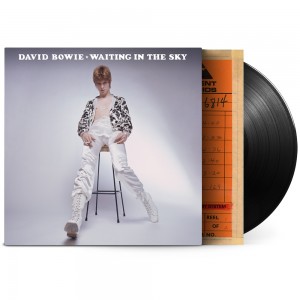Half-Speed Master Vinyl Edition
David Bowie’s Rock ‘n’ Roll Star! Charts Bowie’s journey to Ziggy Stardust. Starting with early home demos, through radio sessions and live performances, to session recordings, outtakes and alternate versions from the recording of The Rise and Fall of Ziggy Stardust album.
The 1LP half-speed master which accompanies the 5CD+BR version features alternative takes and mixes including an alternative version of ‘Lady Stardust’, an unheard version of the deep-cut classic ‘Shadow Man’ and an up-tempo take of The Who’s ‘I Can’t Explain’, which he would later slow down and cover for the PIN-UPS album.
5CD + 1 Blue-Ray Edition
David Bowie’s Rock ‘n’ Roll Star! is a 5CD and 1 Blu-Ray Audio set that explores David Bowie’s journey from February 1971 through the creation of the Ziggy Stardust character, the recording of the iconic The Rise and Fall of Ziggy Stardust and the Spiders From Mars album, and captures the international mania that surrounded the Ziggy phenomenon in the form of UK radio sessions and TV performances, as well as live tracks from Ziggy and the Spiders’ 1st October 1972 show at the Boston Music Hall.
Rock ‘n’ Roll Star! contains 29 unreleased tracks, covers early songwriting demos, recordings from David’s band, The Arnold Corns, rehearsals at Bowie’s then-home, Haddon Hall, BBC sessions, singles, live performances, plus outtakes and alternative versions from the original album recording sessions, which have been newly mixed by original album producer, Ken Scott.
Unreleased highlights include an alternative version of ‘Lady Stardust’, an unheard version of the deep-cut classic ‘Shadow Man’ and an up-tempo take of The Who’s ‘I Can’t Explain’, which he would later slow down and cover for the PIN-UPS album.
The Blu-Ray includes a version of the Ziggy Stardust album called Waiting In The Sky (Before The Starman Came To Earth) taken from Trident Studio tapes dated 15th December 1971, which features an alternative running order and four songs that didn’t make the final album.
Rock ‘n’ Roll Star! also contains two books. The first is an extensive 112-page book with detailed liner notes, memorabilia, contemporary reviews and articles, rare photographs from Barrie Wentzel, Michael Putland, Mick Rock, Sukita and Alec Byrne, as well as brand-new notes and interviews with Ken Scott, Mark Carr Pritchett and David’s plugger from the time, Anya Wilson. Accompanying the main book is a 36-page compiled reproduction of David’s personal Ziggy Stardust era notebooks.
TRACK LISTING
Half-Speed Master Vinyl Edition
Side 1
1. Hang On To Yourself (early Ziggy Session Take)
2. Star (Take 5 Alternative Version)
3. Lady Stardust (Take 1 Alternative Version)
4. Shadow Man (Ziggy Session Version)
5. The Supermen (Ziggy Session Version 2023 Mix)
6. Holy Holy (Ziggy Session Version Alternative Mix)
7. Round And Round (alternative Mix)
Side 2
1. Velvet Goldmine (Ziggy Sessions Outtake 2022 Mix)
2. Looking For A Friend (Ziggy Session Version)
3. It's Gonna Rain Again (Ziggy Sessions Outtake)
4. Sweet Head (Ziggy Sessions Outtake 2022 Mix)
5. Starman (Top Of The Pops Version 2022 Mix)
6. John, I'm Only Dancing (alternative Trident Studios Version)
7. I Can't Explain (Trident Studios Version)
CD/Blu-Ray Edition:
Disc 1
1. So Long 60s (San Francisco Hotel Recording) *
2. Hang On To Yourself (early Demo) *
3. Lady Stardust (demo)
4. Ziggy Stardust (demo)
5. Star (Aka Stars) (demo) *
6. Soul Love (demo And DB Spoken Notes) *
7. Starman (demo 1 Excerpt) *
8. Starman (demo 2) *
9. Moonage Daydream (The Arnold Corns Version)
10. Hang On To Yourself (The Arnold Corns Version)
11. Looking For A Friend (The Arnold Corns Version – Rough Mix) *
12. Haddon Hall Rehearsals Segue: Ziggy Stardust / Holy Holy / Soul Love *
13. Star (Aka Stars) (Haddon Hall Rehearsal) *
14. Sweet Head (Haddon Hall Rehearsal) *
Disc 2
Sounds Of The 70s: John Peel
Session Recorded On 11th January, 1972 And Broadcast On 28th January, 1972
1. Ziggy Stardust *
2. Queen Bitch *
3. Waiting For The Man *
4. Lady Stardust *
Sounds Of The 70s: Bob Harris
Session Recorded On 18th January, 1972 And Broadcast On 7th February, 1972
5. Hang On To Yourself
6. Ziggy Stardust
7. Queen Bitch
8. Waiting For The Man
9. Five Years
Old Grey Whistle Test Performance
Filmed On 7th February, 1972 And Broadcast On 8th February, 1972
Except ‘Oh! You Pretty Things’ Which Was Not Broadcast Until 1982.
10. Oh! You Pretty Things (take 1)
11. Queen Bitch
12. Five Years
Disc 3
Sounds Of The 70s: John Peel
Session Recorded On 16th May, 1972 And Broadcast On 23rd May, 1972
1. White Light/White Heat
2. Moonage Daydream
3. Hang On To Yourself
4. Suffragette City
5. Ziggy Stardust
Johnnie Walker Lunchtime Show
Session Recorded On 22nd May, 1972 And Broadcast From 5th – 9th June, 1972
6. Starman
7. Space Oddity
8. Changes
9. Oh! You Pretty Things
Sounds Of The 70s: Bob Harris
Session Recorded On 23rd May, 1972 And Broadcast On 19th June, 1972
10. Andy Warhol
11. Lady Stardust
12. White Light/White Heat
13. Rock ‘N’ Roll Suicide
Top Of The Pops Performance
Filmed On 5th July, 1972 And Broadcast On 6th July, 1972
14. Starman
Disc 4
1. Round And Round
2. The Supermen (Ziggy Session Version)
3. Holy Holy (Ziggy Session Version)
4. Velvet Goldmine (Ziggy Session Outtake)
5. Starman (original Single Mix)
6. John, I’m Only Dancing (original Single Version)
Recorded Live At The Music Hall, Boston.
Recorded On 1st October, 1972
7. The Supermen
8. Changes
9. Life On Mars?
10. My Death *
11. John, I’m Only Dancing
Disc 5
1. Looking For A Friend (The Arnold Corns Version 2022 Mix) *
2. Hang On To Yourself (early Ziggy Session Take) *
3. Star (take 5 Alternative Version) *
4. Lady Stardust (take 1 Alternative Version) *
5. Shadow Man (Ziggy Session Version) *
6. The Supermen (Ziggy Session Version 2023 Mix) *
7. Holy Holy (Ziggy Session Version Alternative Mix) *
8. Round And Round (alternative Mix)
9. It’s Gonna Rain Again (Ziggy Session Outtake) *
10. Looking For A Friend (Ziggy Session Version) *
11. Velvet Goldmine (Ziggy Sessions Outtake 2022 Mix) *
12. Sweet Head (Ziggy Sessions Outtake 2022 Mix) *
13. Starman (Top Of The Pops Version 2022 Mix)
14. John, I’m Only Dancing (alternative Trident Studios Version) *
15. I Can’t Explain (Trident Studios Version) * Bonus Mix
16. Moonage Daydream (2003 Instrumental Mix)
Blu Ray Audio
THE RISE AND FALL OF ZIGGY STARDUST AND THE SPIDERS FROM MARS
Original Album Mix (96khz/24bit Stereo)
THE RISE AND FALL OF ZIGGY STARDUST AND THE SPIDERS FROM MARS AND EXTRAS
2003 5.1 Mixes (DTS-HD Master Audio 5.1 - 96khz/24bit)
WAITING IN THE SKY (BEFORE THE STARMAN CAME TO EARTH)
Early Ziggy Stardust Album Tracklisting – December 1971 (96khz/24bit PCM Stereo)
THE SINGLES
(96khz/24bit PCM Stereo)
OUTTAKES AND ALTERNATIVE VERSIONS
(96khz/24bit PCM Stereo)

































